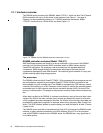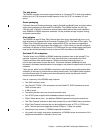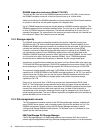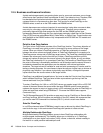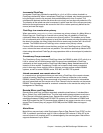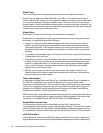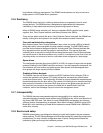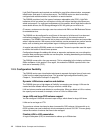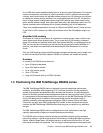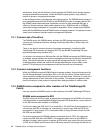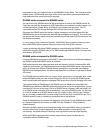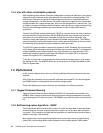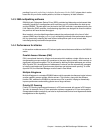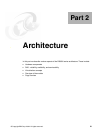14 DS6000 Series: Concepts and Architecture
Light Path Diagnostics and controls are available for easy failure determination, component
identification, and repair if a failure does occur. The DS6000 series can also be remotely
configured and maintained when it is installed in a remote location.
The DS6800 consists of only five types of customer replaceable units (CRU). Light Path
indicators will tell you when you can replace a failing unit without having to shut down your
whole environment. If a concurrent maintenance is not possible, which might be the case for
some double failures, the DS Storage Manager’s GUI will guide you on what to do.
Of course a customer can also sign a service contract with IBM or an IBM Business Partner
for extended service.
The DS6800 can be configured for a call home in the event of a failure and it can do event
notification messaging. In this case an Ethernet connection to the external network is
necessary. The DS6800 can use this link to place a call to IBM or to another service provider
when it requires service. With access to the machine, service personnel can perform service
tasks, such as viewing error and problem logs or initiating trace and dump retrievals.
At regular intervals the DS6000 sends out a heartbeat. The service provider uses this report
to monitor the health of the call home process.
Configuration changes like adding disk drives or expansion enclosures are a non-disruptive
process. Most maintenance actions are non-disruptive, including downloading and activating
new Licensed Internal Code.
The DS6000 comes with a four year warranty. This is outstanding in the industry and shows
IBM’s confidence in this product. Once again, this makes the DS6800 a product with a low
total cost of ownership (TCO).
1.2.9 Configuration flexibility
The DS6000 series uses virtualization techniques to separate the logical view of hosts onto
LUNs from the underlying physical layer. This provides high configuration flexibility (see
Chapter 4, “Virtualization concepts” on page 65).
Dynamic LUN/volume creation and deletion
The DS6800 gives you a high degree of flexibility in managing your storage. LUNs can be
created and also deleted without having to reformat a whole array.
LUN and volume creation and deletion is non-disruptive. When you delete a LUN or volume,
the capacity can be reused, for example, to form a LUN of a different size.
Large LUN and large CKD volume support
You can configure LUNs and volumes to span arrays, which allows for large LUN sizes.
LUNs can be as large as 2 TB.
The maximum volume size has also been increased for CKD volumes. Volumes with up to
65520 cylinders can now be defined, which corresponds to about 55.6 GB. This can greatly
reduce the number of volumes that have to be managed.
Flexible LUN to LSS association
A Logical Subsystem (LSS) is constructed to address up to 256 devices.



